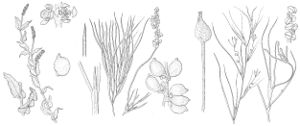Stuckenia
Botanisch-systematische notizen., Abh. Naturwiss. Vereine Bremen 21: 258. 1912.
| Taxon | Illustrator ⠉ | |
|---|---|---|
 | Stuckenia pectinata Ruppia maritima Potamogeton richardsonii | John Myers John Myers John Myers |
Herbs: rhizomes present; turions absent; tubers absent or present. Stems terete, nodes without oil-glands. Leaves submersed, alternate, opaque, sessile, linear, channeled, turgid, acute at base acute, margins entire, apex obtuse to acute, veins 1–5; stipules not tubular, adnate to base of leaf-blades for 2/3 or more length of stipule, extending past adnation as free ligule. Inflorescences spikes, capitate or cylindric, submersed; peduncles flexible, not projecting inflorescence above surface of water. Flowers: pistils 4. Fruits abaxially rounded, beaked or not, turgid; embryo with less than 1 full coil. x = 13.
Distribution
Nearly worldwide
Discussion
The stipules of Stuckenia are adnate to the blade for two-thirds to nearly the entire length of the stipule. The few species of Potamogeton with adnate stipules have the adnation less than half the length of the stipule, in fact, less than 4 mm. Submersed leaves of Potamogeton are translucent, flat, and without grooves or channels, whereas those of Stuckenia are opaque, channeled, and turgid.
A proposal to elevate Potamogeton subgenus. Coleogeton to the generic level, retaining the name Coleogeton, was presented (D. H. Les and R. R. Haynes 1996). Potamogeton pectinatus Linnaeus was chosen as the nomenclatural type. The name Stuckenia had been previously published, however, and P. pectinatus cited (C. Börner 1912), making the generic name Coleogeton superfluous. Stuckenia is the correct name, and the appropriate specific combinations have been made (J. Holub 1997).
Species ca. 6 (4 in the flora).
Selected References
Key
| 1 | Leaf apex acute, apiculate, cuspidate, rarely round; proximal stipular sheaths not inflated; stems abundantly branched, especially on distal portions; fruits distinctly beaked. | > 2 |
| 1 | Leaf apex notched, obtuse, or round, rarely apiculate; proximal stipular sheaths often inflated; stems sparsely branched on distal portions; fruits without beak. | > 3 |
| 2 | Leaves 0.4–1.5–3(–8.5) mm wide; leaf apex apiculate, cuspidate, or rarely round; plants from restricted range in western United States. | Stuckenia striata |
| 2 | Leaves 0.2–1 mm wide; leaf apex acute to mucronate or apiculate; widespread throughout United States and Canada. | Stuckenia pectinata |
| 3 | Stipules with distinct ligules to 20 mm, especially on distal stipules; summit of midstem stipules tight to stem, about the ± same width as stem; fruit 2–3 mm. | Stuckenia filiformis |
| 3 | Stipules without ligules or these to 2 mm on distal stipules; summit of midstem stipules inflated at least 2 times width of stem; fruit 3–3.8 mm. | Stuckenia vaginata |
"not elongating" is not a number.